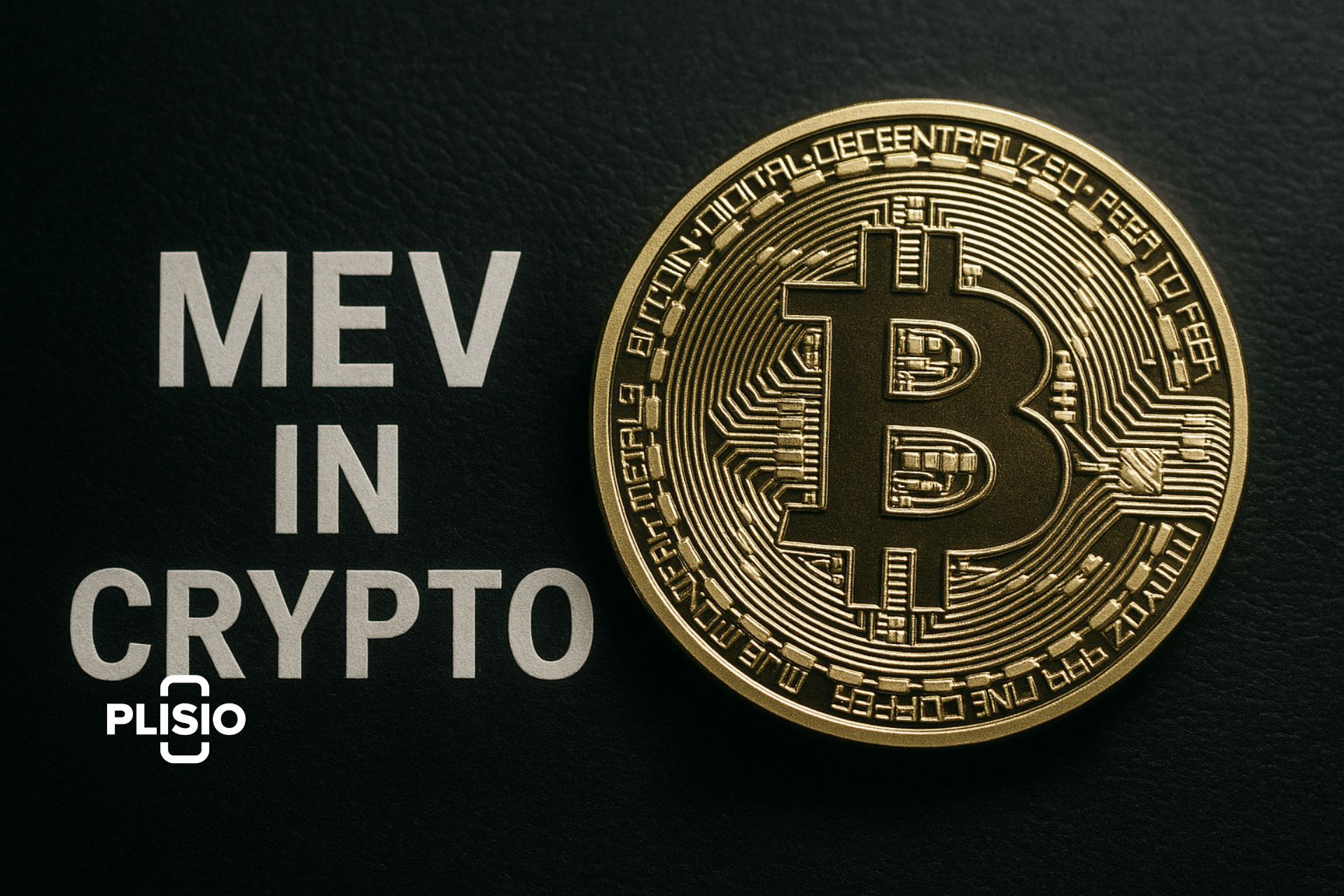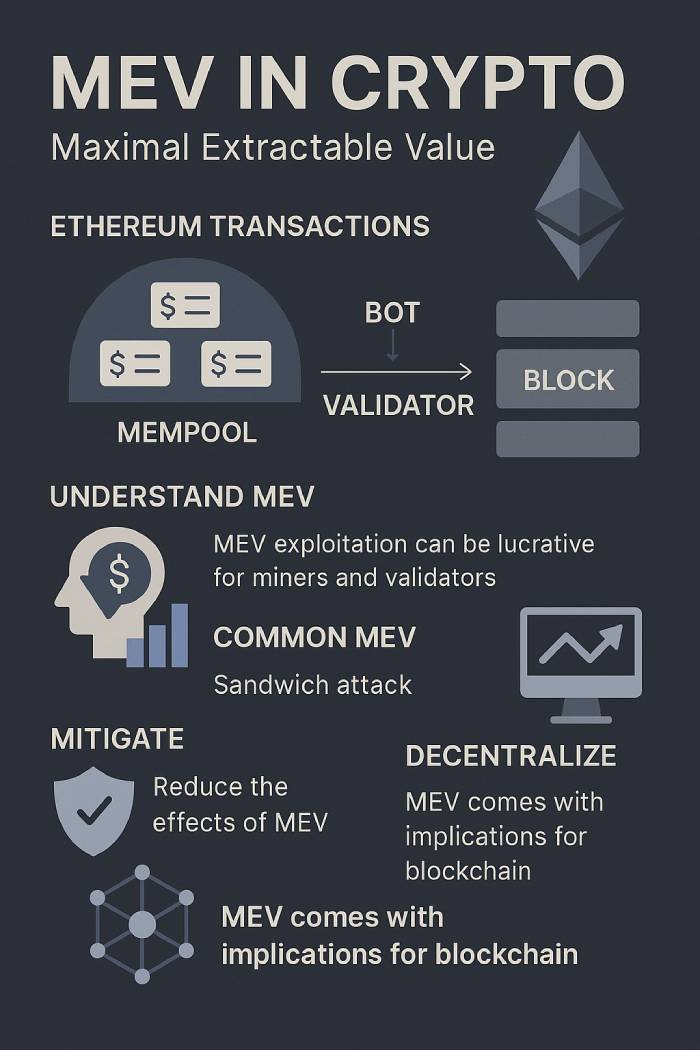MEV in Crypto: What Is Maximal Extractable Value?

In the crypto world, blockchain networks—just like traditional markets—contain inefficiencies. These inefficiencies open up opportunities to extract maximum value, a concept widely recognized today as maximal extractable value (MEV) that can also be included in a block. In simple terms, MEV refers to the profit a miner or validator can earn by strategically reordering, including, or excluding transactions within a block, often leading to higher price volatility.
A public queue of pending transactions dubbed the "mempool" is where every blockchain transaction goes first. Miners or validators can look at the activity flow here and choose how to organize the transactions in a block they suggest. They want to get MEV from profitable gaps in market behavior by optimizing the sequencing of transactions.
This activity plays a big role in how efficient a blockchain becomes, especially in identifying profitable MEV opportunities. However, the impact of MEV is not always positive. When profit is prioritized over fairness, users may experience issues like delayed confirmations, increased gas fees, or front-running—especially in ecosystems like Ethereum, where smart contracts and DeFi applications are widespread. Though Ethereum sees the bulk of MEV activities, any blockchain supporting smart contracts can be vulnerable.
Understanding MEV in Crypto
"Maximal Extractable Value"—often called MEV—has grown into one of the most discussed subjects in cryptocurrency trading and blockchain technology, particularly in the context of crypto exchanges. It’s sometimes described as an invisible tax, quietly collected by network participants who can manipulate how transactions are ordered in a block.
The concept of MEV first took shape in 2019 thanks to a research paper titled "Flash Boys 2.0" by Phil Daian, which outlined how MEV can also be leveraged for profit. But concerns about miners exploiting transaction order date back to 2014, when Reddit user Pmcgoohan raised red flags about this form of MEV attack.
Fast forward to 2025, and MEV extraction is a full-blown industry. According to recent reports, more than $1.3 billion has already been pulled from Ethereum through MEV-related strategies. This growth confirms the deep integration of MEV in decentralized finance (DeFi).
"MEV comes from the way decentralized systems function," says Dan Robinson, Head of Research at Paradigm. "It’s not necessarily harmful—but without mev protection, it threatens the balance of crypto ecosystems."
Understanding how MEV works and the implications of MEV is now essential knowledge for anyone involved in blockchain, especially in sectors like DeFi, crypto trading, and infrastructure development.

How MEV Works in Ethereum and Crypto Networks
MEV originated in DeFi and has become one of the most influential elements shaping blockchain network behavior—particularly in Ethereum, where it defines many MEV transactions. Under the older proof-of-work (PoW) model, this process was called miner extractable value. Now, with Ethereum running on proof-of-stake (PoS), validators take over the role of profit-seeking block producers while creating opportunities for MEV.
Despite this shift, the essence of MEV remains the same: extract value from transactions within a block by manipulating the order to create arbitrage opportunities, capitalize on price differences, or benefit from slippage in trades.
“MEV evolved with the network,” notes Stephane Gosselin of Flashbots, highlighting the need to mitigate MEV risks. “It now includes bots, builders, and searchers who work together or compete to capture profitable MEV opportunities.”
MEV bots scan the mempool for patterns to identify and profit from MEV opportunities. When congestion is high or prices are volatile, they strike quickly—reordering or injecting transactions to gain financial edge. Some prioritize those offering the highest gas fees, while others look for unique arbitrage setups across decentralized exchanges.
Angela Min from the Ethereum Foundation cautions: “The role of MEV actors must be taken seriously to mitigate MEV risks.” MEV can lead to network centralization and unfair access unless mitigated.”
Different Types of MEV Strategies and Their Impact
There are several types of MEV practices, each carrying its own risks and rewards, since MEV can also influence market dynamics and the overall effectiveness of mev protection.
Front-running MEV Bots are a prime example of how MEV can also be detrimental to market fairness.: MEV bots detect pending transactions and jump ahead by placing identical trades with higher gas fees. This creates price movement that favors the bot while hurting the original trader, illustrating the detrimental effects of MEV transactions and the need for robust mev protection.
Sandwich Attack Examples: A typical sandwich attack involves placing a buy transaction before and a sell after a victim’s trade, manipulating token prices within a DEX. The user suffers from price impact and slippage, while the attacker extracts value through common MEV strategies.
"Sandwich attacks are among the most visible examples of MEV," says Georgios Konstantopoulos, CTO at Paradigm, highlighting the need for tools to protect yourself from MEV. “They show how transparency can be weaponized.”
DEX Arbitrage Opportunities often arise as profitable MEV opportunities in the cryptocurrency market, where maximal extractable value can be included in a block.: Bots spot price discrepancies between DEXs. By buying low on one and selling high on another, they profit from inefficiencies while realigning token prices across platforms.
DeFi Liquidation MEV SearchersIn lending protocols like Aave or Compound, undercollateralized positions are liquidated, which can lead to potential MEV scenarios. MEV searchers race to trigger these events for rewards. While this helps stabilize protocols, it also fuels intense competition, as MEV can also lead to aggressive strategies among participants.
Tools for mev protection are becoming increasingly vital in the evolving landscape of blockchain technology.Flashbots Protect and MEV-Boost are designed to allow fairer MEV extraction and help ensure that maximal extractable value can be included in a block, enhancing overall mev protection. These systems reduce harmful MEV by routing transactions privately, thus protecting yourself from MEV and minimizing negative outcomes.
The Role of MEV in the Crypto Ecosystem
Not every MEV strategy is harmful, and some can even lead to profitable MEV opportunities. Some MEV examples—like DEX arbitrage—actually enhance market efficiency. Others, like liquidations, are essential to DeFi’s risk management.
MEV plays a dual role: it reflects the incentives built into crypto infrastructure and tests the limits of decentralization, since MEV can also create opportunities for front-running. Key benefits include:
- More accurate pricing across decentralized exchanges
- Additional block rewards for validators and miners
- Faster allocation of liquidity in volatile conditions
Even Ethereum co-founder Vitalik Buterin has acknowledged that MEV is essential due to its complex nature, and that it can also pose challenges for mev protection. “MEV isn't evil by default; it can also represent the maximum amount of value that can be extracted from transactions under certain conditions.” But to keep it from becoming harmful MEV, we must engineer systems that distribute opportunity more fairly and limit the maximum amount of value extracted by malicious actors,” he said in a 2024 podcast.
As blockchain evolves, so do the tools designed to reduce MEV risks. Solutions like encrypted mempools, intent-based smart contracts, and fair sequencing services are emerging to protect users and improve the MEV ecosystem, contributing to effective mev protection.
MEV in Crypto: Future Challenges and Protection Strategies
The concept of MEV has become central to understanding how decentralized finance operates today and the effects of MEV on market dynamics, especially in terms of MEV examples. Whether you’re a developer, trader, or validator, learning how MEV works is crucial to thriving in this landscape.
As of 2025, MEV profits on Ethereum alone have surpassed $1.3 billion. The crypto industry is actively working on ways to reduce MEV exploitation while encouraging good MEV practices and maximizing opportunities for maximal extractable value (MEV) to be included in a block.
The implications of MEV reach far beyond transaction fees or gas spikes. They affect network consensus, transaction integrity, and user trust. MEV may never disappear—but the goal is to build fairer systems that manage its effects.
“Don’t ignore MEV,” concludes Angela Min. “If you’re part of the blockchain space, you need to understand MEV to protect yourself from MEV—and maybe even profit from it, as MEV is essential in today's market.”




